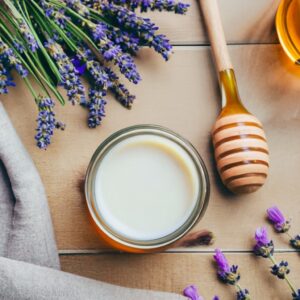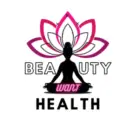
Crafting a luxurious bath experience doesn’t have to be complicated. This DIY Honey and Lavender Milk Bath recipe brings an old-fashioned charm to your self-care routine while offering remarkable benefits for your skin. Milk baths, a delightful departure from standard bath salts, are simple, cost-effective, and evoke a cozy, nostalgic ambiance.
For centuries, both honey and milk have been cherished for their skin-loving properties, with legends even attributing Cleopatra’s beauty to these natural elements. Milk, enriched with lactic acid and proteins, tenderly nurtures the skin, leaving it irresistibly smooth. As for honey its benefits are manifold! From its soothing and hydrating qualities to its cleansing and healing properties, honey truly is a skincare wonder.
DIY Honey and Lavender Milk Bath recipe

This particular DIY Honey and Lavender Milk Bath recipe holds a special place for me. Its sweet fragrance and calming effect are ideal for unwinding and relaxing.
Ingredients:
- 3/4 cup powdered milk
- 1/4 cup honey powder
- 10-20 drops lavender essential oil (adjust for preferred fragrance strength)
- 1 tablespoon dried lavender buds (optional)
Instructions:
Step 1: Combine powdered milk and honey powder in a blender, ensuring a smooth mixture. If a blender isn’t available, hand mixing with a fork works well to eliminate clumps.
Step 2: Gradually add drops of lavender essential oil to the milk-honey blend, thoroughly integrating it for at least 30 seconds. For manual mixing, whisk briskly while adding the essential oil to avoid clumps.
Tip: Using a device like the Magic Bullet simplifies this process, ensuring a seamless blend.
Step 3: Transfer the milk and honey amalgamation into a bowl, gently folding in the dried lavender buds by hand. While these buds add visual appeal, if you prefer a herb-free bath, feel free to omit them.
Usage: Pour approximately 1/4 cup of this bath milk into running bathwater and luxuriate in it for a minimum of 20 minutes.
Yield: Yields about 4 baths.
Shelf life: This bath milk retains its quality for up to 12 months when stored on your bathroom shelf.
Enhance Your Skincare Journey:
Did you relish the experience of the honey and lavender milk bath? If you’re eager to delve deeper into crafting natural skincare solutions for radiant, healthy skin, consider joining my complimentary email course, “Handmade Skin Care for Beginners.” Discover simple yet effective herbal skincare routines tailored to pamper your skin.
benefits of DIY Honey and Lavender Milk Bath

Lactic Acid: The Skin’s Rejuvenator
Exfoliation and Renewal: How lactic acid in milk gently exfoliates, removing dead skin cells for a brighter complexion.
Enhanced Hydration: Exploring how milk’s proteins lock in moisture, providing deep hydration and improving skin texture.
Honey’s Healing Touch: Antioxidants and Beyond
Antioxidant Protection: Unveiling honey’s antioxidants and their role in safeguarding the skin against environmental damage and premature aging.
Antibacterial Marvel: Understanding how honey’s antibacterial properties aid in calming and cleansing the skin, particularly for sensitive or acne-prone skin.
Nourishment & Restoration: Synergy of Milk and Honey
Holistic Skincare: Exploring how the combined properties of milk and honey nurture, protect, and restore the skin’s health and vitality.
Historical Significance Meets Modern Science: Tracing the ancient roots of milk and honey skincare rituals and validating their efficacy through contemporary scientific understanding.
Natural Moisturization: Radiant Glow Unveiled
Humectant Magic: Unraveling how honey’s humectant nature draws moisture from the environment, keeping skin supple and glowing.
Hydration Beyond the Surface: Discussing how milk’s deep-penetrating hydration maintains skin elasticity and diminishes fine lines.
Skincare Harmony: DIY Honey and Lavender Milk Bath Benefits
Soothing and Relaxation: Explaining how the bath’s combination promotes relaxation and tranquility, enhancing the overall skincare experience.
Long-Term Skin Health: Highlighting the prolonged benefits of integrating this DIY bath into a regular skincare routine for healthy, radiant skin.
customization options and variations:
| Customization | Ingredients | Benefits for Skin | Recommended Quantity |
|---|---|---|---|
| Essential Oils | Lavender (default) | Calming and Relaxing | 10-20 drops |
| Chamomile | Soothing and Anti-Inflammatory | 10-15 drops | |
| Eucalyptus | Invigorating and Clarifying | 10-15 drops | |
| Rosemary | Stimulating and Rejuvenating | 10-15 drops | |
| Additional Ingredients | Colloidal Oatmeal | Gentle Exfoliation and Skin Calming | 2 tablespoons |
| Dead Sea Salt | Detoxification and Improved Circulation | 1/4 cup | |
| Rose Petals | Aromatic and Hydrating | 2 tablespoons | |
| Coconut Milk Powder | Extra Nourishment and Hydration | 1/4 cup | |
| Combination Variations | Lavender + Chamomile | Double Calming Effect | Adjust essential oil quantities |
| Rosemary + Eucalyptus | Invigorating and Clarifying Blend | Adjust essential oil quantities | |
| Dead Sea Salt + Coconut Milk Powder | Detoxifying and Nourishing Combo | Adjust quantities accordingly |
Note: Adjust quantities based on personal preferences and skin sensitivity. Conduct a patch test for new ingredients to ensure compatibility.
This table provides a comprehensive guide for customizing the bath recipe, allowing individuals to tailor the experience to their specific needs, preferences, and skin types.
Skin Care Tips:

Here are some skincare tips that complement the use of the DIY Honey and Lavender Milk Bath, enhancing its benefits and contributing to a holistic skincare routine:
Pre-Bath Preparation: Gentle Exfoliation
Prior to the milk bath, indulge in a gentle exfoliation routine. Use a mild scrub or a soft brush to slough off dead skin cells, allowing the milk bath’s hydrating and softening properties to penetrate more effectively.
Milk Bath Soak: Enhance Relaxation
Dim the lights, play calming music, or add a few drops of lavender essential oil to the room to create a serene ambiance. Relaxation amplifies the bath’s benefits, reducing stress and promoting overall well-being.
Post-Bath Ritual: Hydration and Locking in Moisture
After the bath, pat the skin gently with a towel to leave some moisture on the skin. Follow up immediately with a nourishing moisturizer or body oil to seal in the hydration from the milk bath, leaving the skin supple and hydrated.
Weekly Treatment: Face Mask or Skin Treatment
Use the milk bath as part of a weekly spa-like treatment. Follow it up with a hydrating face mask or any targeted skin treatment to maximize the skin-renewing effects of the bath and address specific skincare concerns.
Mindful Hydration: Drink Water
Hydrate internally by drinking water before and after the milk bath. Adequate hydration supports skin health from within, complementing the external benefits of the bath.
Consistent Routine: Regular Use
Incorporate the milk bath into your skincare routine regularly, whether weekly or bi-weekly, to maintain the skin’s health and maximize the cumulative benefits over time.
Sun Protection: Apply SPF
If enjoying the milk bath during the day, follow up with a broad-spectrum SPF to shield the skin from UV damage and maintain its health.
Safety Precautions for Sensitive Skin and Allergies:

Patch Testing: Before indulging in a full bath, conduct a patch test. Apply a small amount of the milk bath mixture to a small area of skin (such as the inner arm) and wait for 24 hours. If any irritation, redness, or discomfort occurs, refrain from using the bath.
Ingredient Sensitivities: Individuals with known allergies to dairy, honey, or specific essential oils should avoid using this bath or opt for alternative ingredients to prevent adverse reactions.
Consultation with a Dermatologist: If you have a history of skin conditions, allergies, or dermatological concerns, consulting a dermatologist or healthcare professional before using new skincare products is advisable.
Essential Oil Caution: Essential oils, while beneficial, can be potent. Always dilute them appropriately, and if pregnant, nursing, or undergoing medical treatment, consult a healthcare provider before using essential oils.
General Recommendations:
Avoid Eyes and Open Wounds: When using the milk bath, prevent contact with eyes, as well as any open cuts or wounds.
Rinse After Bath: Ensure thorough rinsing after the bath to remove any residue from the skin.
Storage: Store the DIY bath mixture in a cool, dry place away from direct sunlight. Ensure containers are sealed properly to maintain freshness and potency.
Discontinue Use if Irritation Occurs: If any discomfort, irritation, or adverse reactions arise during or after the bath, discontinue use immediately and rinse off thoroughly.
FAQ’S
Do you need to rinse after a milk bath?
Yes, it’s recommended to rinse off after a milk bath to remove any residue from the skin.
How long does a milk bath last?
The benefits of a milk bath can linger on the skin, providing hydration and softness even after rinsing. However, the experience itself typically lasts as long as your bath session.
Why do you put milk in a baby’s bath?
Adding milk to a baby’s bath can help moisturize their skin and provide relief from dryness or irritation.
Do you smell after a milk bath?
Generally, no, as long as you rinse thoroughly after the milk bath. The lingering scent might be subtle and pleasant due to added fragrances like lavender.
What kind of milk is used for milk baths?
Powdered milk, whole milk, or even goat’s milk can be used for milk baths.
Are milk baths good for you?
Milk baths can offer benefits like hydration, softening the skin, and potentially soothing irritation or dryness.
Can I use pump and dump milk for baths?
It’s advisable not to use expressed milk intended for feeding for other purposes, including baths.
Are you supposed to use soap in a milk bath?
Soap isn’t necessary in a milk bath, as the milk itself can cleanse and soften the skin.
Can I use leftover breast milk for a milk bath?
Using leftover breast milk for a bath isn’t recommended; it’s better to reserve expressed milk for feeding purposes.
Can you breastfeed if you are sober?
Yes, it’s safe to breastfeed while sober.
What does a honey bath do?
A honey bath can moisturize and nourish the skin due to honey’s hydrating properties.
How do you make a honey bath?
You can add a few tablespoons of honey to warm bathwater for a honey bath.
Is honey good for showering?
Honey can be beneficial for the skin in a shower, providing moisture and potential antibacterial properties.
Can you put honey in your lotion?
Yes, honey can be added to lotions or used in homemade skincare products for added benefits.
Can you use raw honey as a body wash?
Raw honey can be used as a natural body wash due to its cleansing and moisturizing properties.
How much honey do you put in bath water?
You can add a few tablespoons of honey to your bathwater for a honey bath.
Can I rub honey all over my body?
Yes, honey can be gently applied to the skin for its moisturizing and soothing effects.
Is raw honey good for bacterial infection?
Raw honey has natural antibacterial properties that may help with certain bacterial infections when applied topically.
Is it OK to put lavender in the bath?
Yes, lavender can be added to bathwater for its calming and aromatic properties.
What are the benefits of a lavender bubble bath?
A lavender bubble bath can promote relaxation, ease stress, and potentially aid in better sleep due to lavender’s calming effects.
How do you add lavender to a bath?
Adding a few drops of lavender essential oil or dried lavender flowers to bathwater is a common way to incorporate lavender into a bath.
How much lavender do I put in my bath?
Start with a few drops of lavender essential oil or a small handful of dried lavender flowers, adjusting based on personal preference.
How does lavender calm the body?
Lavender contains compounds that interact with the nervous system, potentially reducing anxiety and promoting relaxation.
Is lavender as effective as Xanax?
Lavender may have calming effects, but it’s not a substitute for medications like Xanax. Always consult a healthcare professional for anxiety treatment.
What does lavender do to your brain?
Lavender’s aroma may impact brain activity, potentially promoting relaxation and reducing stress.
Does lavender actually help anxiety?
Some studies suggest that lavender’s aroma may help reduce anxiety symptoms in some individuals, but further research is ongoing.
